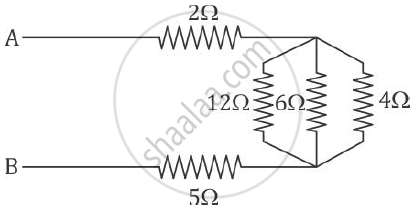Advertisements
Advertisements
प्रश्न
If two resistors of 25 Ω and 15 Ω are joined together in series and then placed in parallel with a 40 Ω resistor, the effective resistance of the combination is :
(a) 0.1 Ω
(b) 10 Ω
(c) 20 Ω
(d)40 Ω
उत्तर
(c) 20 Ω
When 25 Ω and 15 Ω are connected in series, then:
Total resistance, R = 25 + 15 = 40 Î
This 40 Î is connected in parallel with the 40 Î resistor.
Therefore, the net resistance = 40 / 2 = 20 Î
APPEARS IN
संबंधित प्रश्न
A battery of 9 V is connected in series with resistors of 0.2 Ω, 0.3 Ω, 0.4 Ω, 0.5 Ω and 12 Ω, respectively. How much current would flow through the 12 Ω resistor?
Find the equivalent resistance between points A and B.

If the length of a wire is doubled by taking more of wire, what happens to its resistance?
The diagram below shows part of a circuit:

If this arrangement of three resistors was to be replaced by a single resistor, its resistance should be:
(a) 9 Ω
(b) 4 Ω
(c) 6 Ω
(d) 18 Ω
State expression for Resistance connected in parallel.
Calculate the equivalent resistance between the points A and B for the following combination of resistors:
Three resistors of 6Ω, 3Ω and 2Ω are connected together so that their total resistance is greater than 6Ω but less than 8Ω Draw a diagram to show this arrangement and calculate its total resistance.
What is the equivalent resistance between the points X and Y for the given network?
The resistance of the hot filament of the bulb is about 10 times the cold resistance. What will be the resistance of 100 W-220 V lamps, when not in use?
When a 4 Ω resistor is connected across the terminals of a 2 V battery, the number of coulombs passing through the resistor per second is:
